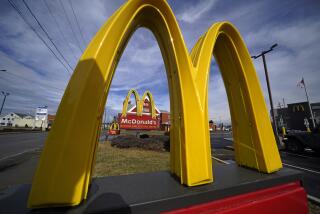U.S. Beef Sales in Japan Fall Victim to E. Coli Scare
The latest victim of Japan’s mysterious E. coli outbreak is the promising $2.1-billion market there for U.S. beef, which has suffered a 30% to 50% drop in sales recently as frightened consumers add red meat to their list of possible villains.
U.S. beef exporters fear the recent free fall in their most lucrative foreign market could accelerate with this week’s news that the virulent strain of E. coli bacteria known as 0157:H7 was found in four beef samples, one from a shipment of U.S. beef intestines and three from beef produced in Japan.
In the six months before the E. coli outbreak, U.S. beef exports to Japan jumped 17% over the previous year. Sales of U.S. beef to Japan totaled $2.1 billion in 1995, up from $701 million in 1987.
Japanese and U.S. government officials were quick to point out that there has been no link between U.S. beef and the deadly food-poisoning epidemic that has claimed 11 lives and sickened more than 9,500 people in Japan since June.
The tainted shipment of U.S. beef intestines was destroyed before it was distributed in Japan. E. coli is a naturally occurring bacteria found in cows’ internal organs, particularly the intestines. The bacteria is killed by high temperatures in cooking.
Since the baffling outbreak first surfaced in Japan, it has been blamed on a host of culprits, including raw radish sprouts, lettuce, tainted water and, in one instance, raw beef liver.
But the Japanese government, which is working with the Atlanta-based Centers for Disease Control and Prevention, has not yet pinpointed the cause of this summer epidemic. And lacking a concrete villain, frightened Japanese consumers have decided to stay clear of all possible carriers, particularly foreign beef, according to Bruce Berven, executive director of the California Beef Council.
He believes the fears about U.S. beef were aggravated by the widespread publicity about the 1993 outbreak of E. coli poisoning in the Pacific Northwest, which was eventually traced to undercooked hamburgers served at Jack in the Box fast-food restaurants.
Although Japan’s E. coli outbreak appears to be lessening, with fewer cases reported in recent weeks, the consumer wariness about the safety of foreign beef could be renewed by this week’s news that the bacteria was found in a U.S. beef shipment.
“We’re alarmed that the report that came out could continue to put doubts in the minds of Japanese consumers,” Berven said. “But over the long term, we’re confident that our market share will come back.”
Although the decline in sales to Japan is not likely to cause financial hardship for U.S. beef producers--which still depend largely on domestic sales--the situation nonetheless is disheartening. The U.S. beef industry, facing sluggish domestic demand, is counting on exports to fuel its growth and has enjoyed an explosion in the Japanese market because of a relaxation of trade barriers, the strong yen--which has made imported products cheaper--and a greater openness to foreign products.
The E. coli outbreak is the second food poisoning scare to hit the U.S. beef industry. Earlier this year, it saw beef sales in the Asia Pacific region take a nose dive after there were reports that linked the deadly “mad cow disease” in Britain to humans.
Since the E. coli scare first surfaced in Japan, U.S. beef shippers and exporters have reported a drop of 30% to 50% in business, according to industry sources.
James Geller, regional director of Asia Pacific sales for H. Shenson International, a major San Francisco-based exporter, said his company’s business has not been badly damaged because it sells high-end beef products to hotels, restaurants and airlines.
But Geller said the U.S. beef export business overall has been “deeply hurt” by the E. coli scare.
“A lot of the major packing houses, their business is down at least 50%,” he said.
Geller pointed out that the U.S. beef industry already operates under the world’s most rigorous quality and inspection regulations. And the U.S. Department of Agriculture--spurred by the Jack in the Box epidemic--recently implemented even tougher meat and poultry inspection rules designed to reduce the levels of harmful bacteria in food and improve industrywide sanitation procedures.
In coming weeks, the U.S. Meat Export Federation, the California Beef Council and others will be working on a campaign in Japan to educate consumers about the high quality of U.S. meat and the importance of safe food handling.
This is of particular concern in many countries in Asia, where internal organs such as the liver and intestines are commonly eaten and there is a tradition of consuming certain kinds of meat or fish raw.
“The fears will subside and the [beef] market will eventually come back,” said Jeff Oates, communications director for the U.S. Meat Export Federation in Denver, which represents about 100 U.S. firms. “The good news in this is that there is a significant increase in the public’s awareness of bacterial contamination.”
More to Read
Inside the business of entertainment
The Wide Shot brings you news, analysis and insights on everything from streaming wars to production — and what it all means for the future.
You may occasionally receive promotional content from the Los Angeles Times.









